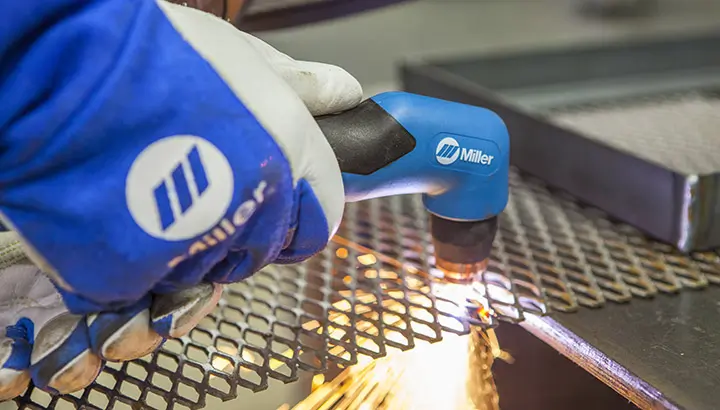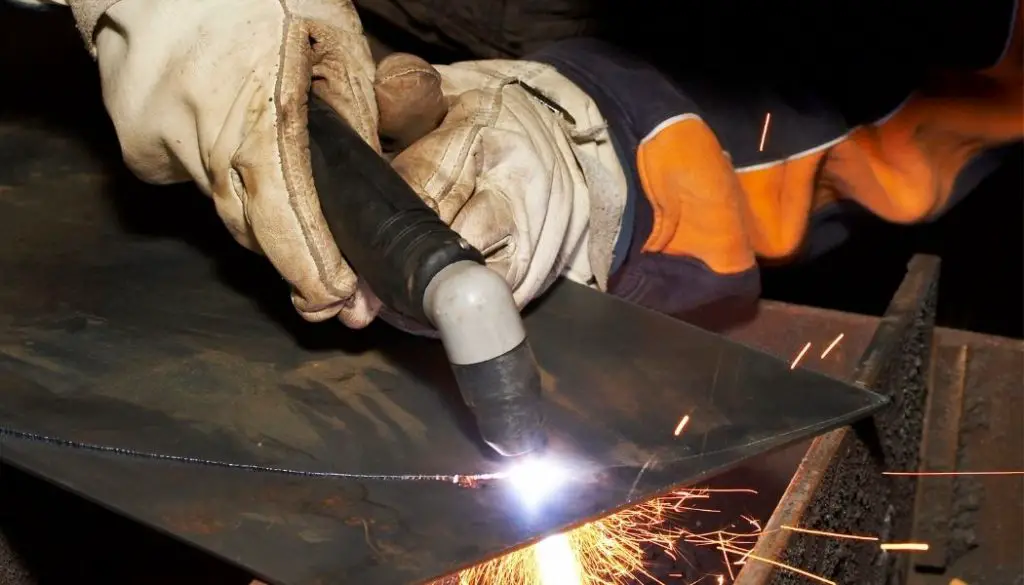Yes, you can cut aluminum with a plasma cutter, as it is effective on conductive metals. Plasma cutting offers clean, precise cuts with minimal heat-affected zones and is suitable for various aluminum thicknesses. The process is efficient and versatile, making it a popular choice for cutting aluminum.
Modern plasma cutters are designed to cut through most conductive metals, including aluminum, with relative ease. Current handheld cutting systems can slice through aluminum sheets up to 1 to 1.5 inches in thickness, while industrial systems can slice through aluminum up to 6 inches in thickness.

Table of Contents
How to Use a Plasma Cutter to Cut Through Aluminum
Plasma cutters work by using a concentrated stream of superheated ionized gas to slice through conductive metals, such as:
- Mild steel: low-carbon steel commonly used in car fabrication
- Stainless steel
- Carbon steel
- Expanded steel
- Copper
- Brass
- Iron
- Aluminum
Compared to other conductive metals, aluminum has a lower melting point, presenting some unique challenges when cutting soft metal. An important factor in achieving a quality cut of aluminum is the gas mixture used in the system.
Plasma cutters use two types of gas: a shield gas and a plasma gas.
Plasma Gas Choices
Plasma gas is a gas mixture that’s concentrated and superheated at the nozzle to produce the cutting stream. Plasma gasses can be comprised of any of the following mixtures:
- Compressed Air (78% Nitrogen + 21% Oxygen)
- 99.5% Oxygen
- 99.9% Nitrogen
- H-35 (35% Hydrogen + 65% Argon)
- F5 (5% Hydrogen + 95% Nitrogen)
Each plasma gas differs in how the ionized gas particles interact with specific conductive metal particles. So to achieve the best quality cuts, you’ll want to keep in mind the ideal gas for the metal you’re working with.
For example, when cutting aluminum, nitrogen provides a cleaner and speedier cut than other plasma gasses.
In contrast, nitrogen is a less-than-ideal choice when cutting through mild steel; oxygen would give a cleaner cut.
Choosing a plasma gas is not the only important factor in getting a good quality cut; you also have to choose the right shield gas to pair with your plasma gas.
Shield Gas Choices
Shield gasses swirl and envelope the end of the nozzle and serve some important functions:
- Cool the nozzle and the material to be cut, preventing overheating.
- Blow away dust and debris from the surface to be cut.
- Blow away molten metal to prevent it from getting in the way of cutting contact.
- Prevent atmospheric air from oxidizing the cut
- Focus the torch head
There are four gas mixtures commonly used as shield gasses:
- Compressed Air (78% Nitrogen + 21% Oxygen)
- 99.5% Oxygen
- 99.9% Nitrogen
- Carbon Dioxide (CO2)

Plasma/Shield Gas Combinations for Cutting Aluminum
Some shield gasses pair better with specific plasma gasses, depending on the type and thickness of the metal to be cut. For aluminum cutting, the following combinations are often recommended, each with its own pros and cons:
| Plasma/Shield | Pros | Cons |
Air/Air | Economic and readily available. Good cutting speed and qualityCan cut through 1/2 inches or less | Air needs to be filtered for contaminants. Can introduce porosity to the cut edge, affecting weld quality |
Nitrogen/CO2 | Provides high-quality cuts and speed. Can cut through 1/2 inches or less | CO2 can be costly. Not recommended for thickness exceeding 1/2 inches |
Nitrogen/Air | Provides high-quality cuts and speed. Can cut through 1/2 inches or less | Not as fast and as clean a cut as CO2. Not recommended for thickness exceeding 1/2 inches |
H-35/Nitrogen (Argon-Hydrogen/Nitrogen) | Maximum cutting capability. High-quality cut and speed. Is well-suited for thicknesses greater than 1/2 inches, up to 3 inches, with handheld cutters. | Costs higher than other options. May produce a jagged edge on the bottom of the cut. Not recommended for thickness less than 1/2 inches. |
The air/air combination is the most economical and readily available option, especially for general-purpose or home DIY projects. Some plasma cutter systems come with a built-in air compressor, eliminating the need for purchasing a separate air compressor and adapter.
However, the air/air combination has a higher chance of oxidation during the cutting process, which can affect the quality of plasma welds done on the metal. When metal oxidizes, it will require a higher temperature to melt and manipulate.
In terms of welding, oxidation can cause uneven welds, which negatively affects the weld’s visual presentation and structural strength. While this may not be an issue for home projects, you’ll want the cleaner, unoxidized cuts offered by nitrogen combinations for commercial use.
For aluminum thicknesses less than ½ inch, the air and nitrogen plasma combination can produce clean and speedy cuts.
However, when tackling aluminum thicknesses more than ½ inch thick, it’s best to opt for the H-35 (Argon-Hydrogen) combination, as it produces the hottest flame and smoothest cut compared to the other options.
Using H-35 on thinner cuts is possible, but the high heat produced can cause issues while cutting.
Plasma Cutter Consumables
Using a plasma cutter inevitably leads to wear and tear, as with any machine. Consumables are parts of the plasma cutter that must be replaced after repeated usage.
Consumables include:
- Swirl Ring: causes the shield gas to constantly swirl around the plasma torch, keeping it focused and preventing the nozzle from overheating
- Nozzle: the aperture where the plasma gas is focused through. Nozzles have different sizes depending on the type of cutting.
- Electrode: a thin piece of copper-hafnium that receives electric charge and arcs that charge onto the cut material
- Shield Cap: protects the nozzle from sparks and molten metal created during the cutting process.
- Retaining Cap: holds all the consumable parts of the plasma cutter together near the nozzle
It’s important to keep track of the condition of your consumables to ensure that your plasma cutter is performing optimally and to reduce the chances of any hazards.
Refer to your machine’s maintenance manual for the proper parts information and instructions on replacing your consumables.
Conclusion
Modern plasma cutters are designed to cut through aluminum with the right combination of plasma and shield gasses.
Using filtered shop air as a plasma and shield gas is an economical and versatile choice for general-purpose use and home DIY projects, with a few caveats concerning oxidation and weld quality.
Other plasma and shield gas options are available for cleaner and speedier cuts on aluminum but come with a higher expense.
